CO7207 - UML Modeling and Programming with EMF Project Solution 2019
VerifiedAdded on 2023/04/21
|10
|850
|427
Project
AI Summary
This document presents a solution to a UML modeling and programming project using EMF, focusing on an online bookshop system. It includes a system description outlining stakeholders, business entities, and use cases. The behavioral model is detailed with use case and activity diagrams, illustrating customer interactions such as purchasing books and admin functionalities like managing the book inventory. The structural model features a class diagram representing the system's architecture and OCL constraints to enforce business rules. An object diagram provides a snapshot of the system's state. Finally, the document demonstrates model instantiation by creating a plugin project and generating code to save the model instance, highlighting the practical application of EMF in software development. Desklib provides similar past papers and solved assignments for students.
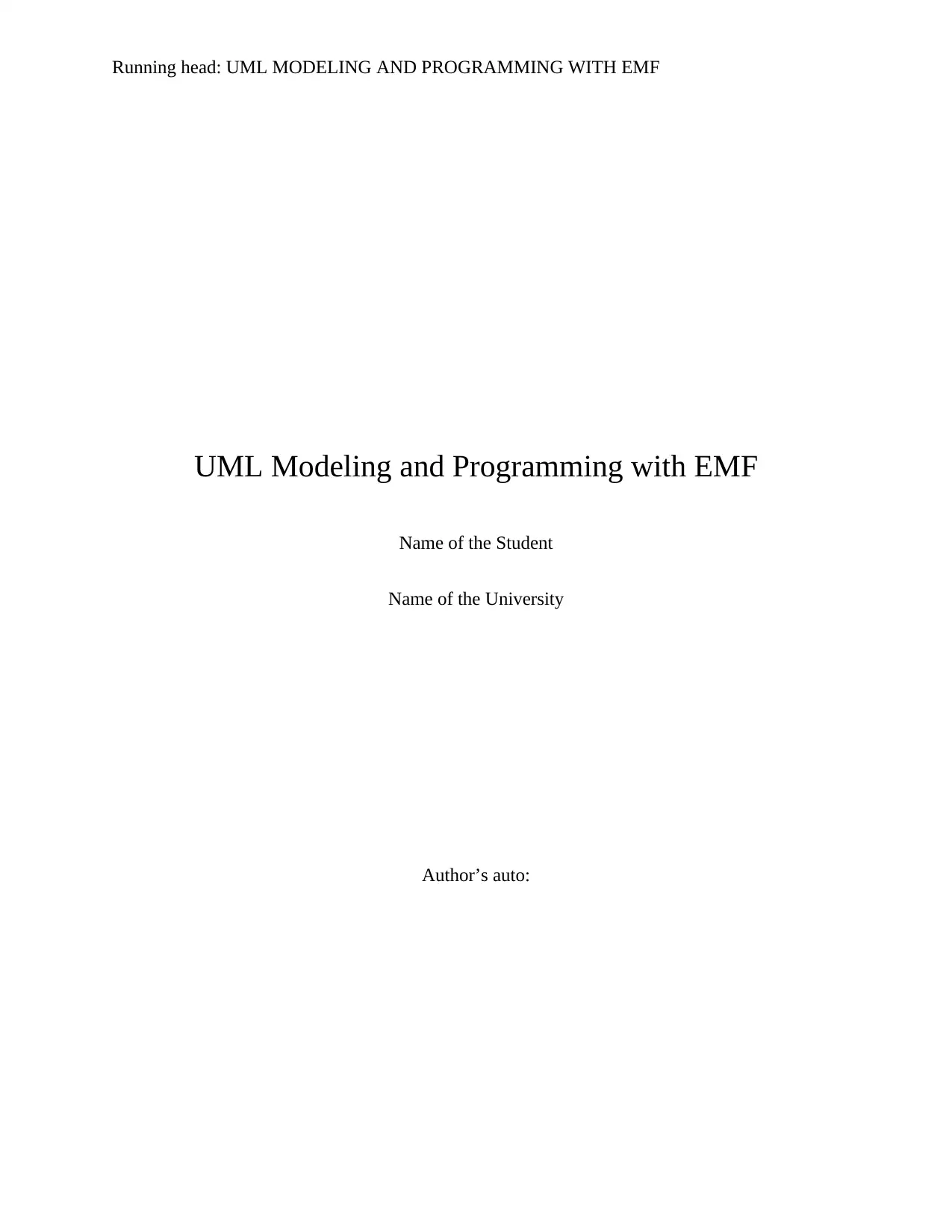
Running head: UML MODELING AND PROGRAMMING WITH EMF
UML Modeling and Programming with EMF
Name of the Student
Name of the University
Author’s auto:
UML Modeling and Programming with EMF
Name of the Student
Name of the University
Author’s auto:
Paraphrase This Document
Need a fresh take? Get an instant paraphrase of this document with our AI Paraphraser
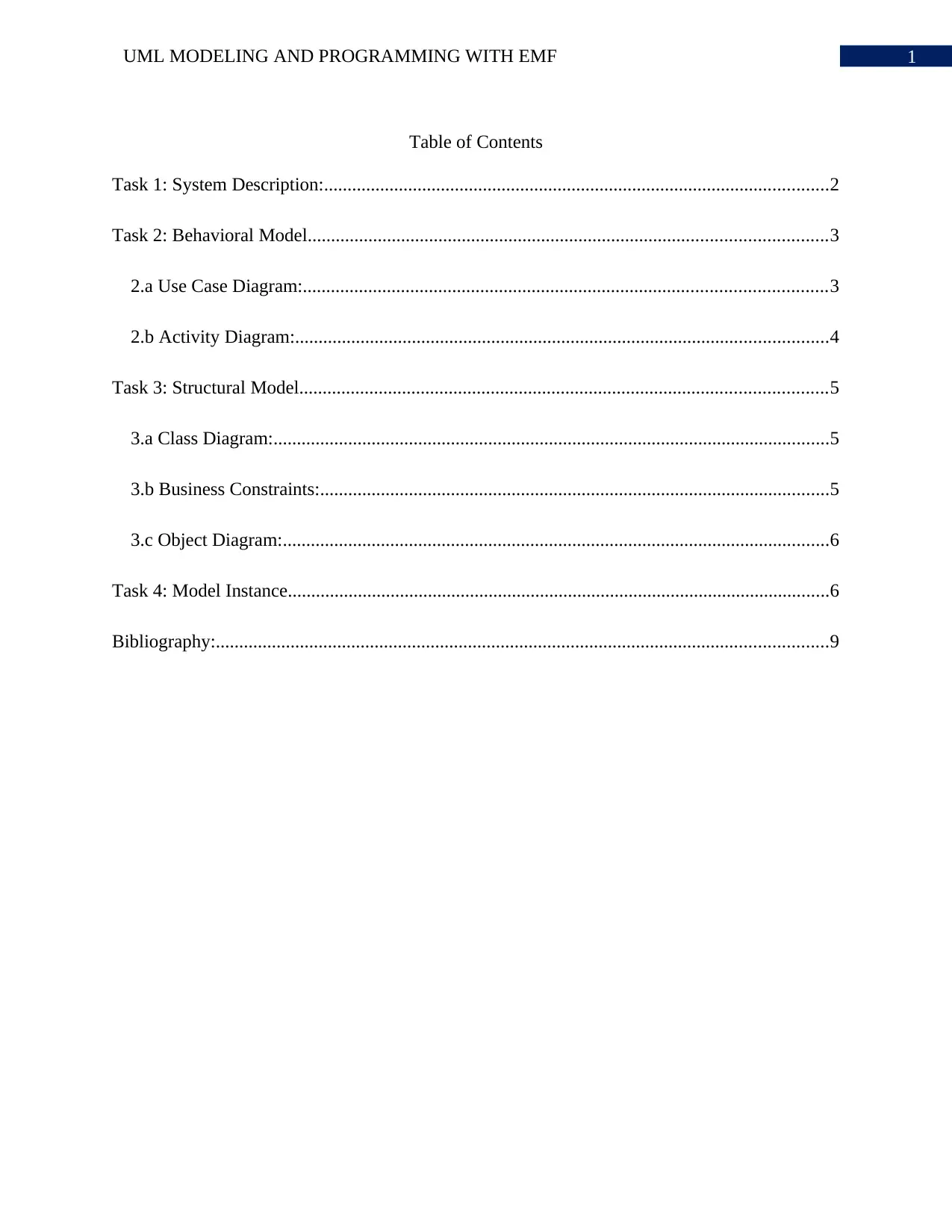
1UML MODELING AND PROGRAMMING WITH EMF
Table of Contents
Task 1: System Description:............................................................................................................2
Task 2: Behavioral Model...............................................................................................................3
2.a Use Case Diagram:................................................................................................................3
2.b Activity Diagram:..................................................................................................................4
Task 3: Structural Model.................................................................................................................5
3.a Class Diagram:.......................................................................................................................5
3.b Business Constraints:.............................................................................................................5
3.c Object Diagram:.....................................................................................................................6
Task 4: Model Instance....................................................................................................................6
Bibliography:...................................................................................................................................9
Table of Contents
Task 1: System Description:............................................................................................................2
Task 2: Behavioral Model...............................................................................................................3
2.a Use Case Diagram:................................................................................................................3
2.b Activity Diagram:..................................................................................................................4
Task 3: Structural Model.................................................................................................................5
3.a Class Diagram:.......................................................................................................................5
3.b Business Constraints:.............................................................................................................5
3.c Object Diagram:.....................................................................................................................6
Task 4: Model Instance....................................................................................................................6
Bibliography:...................................................................................................................................9
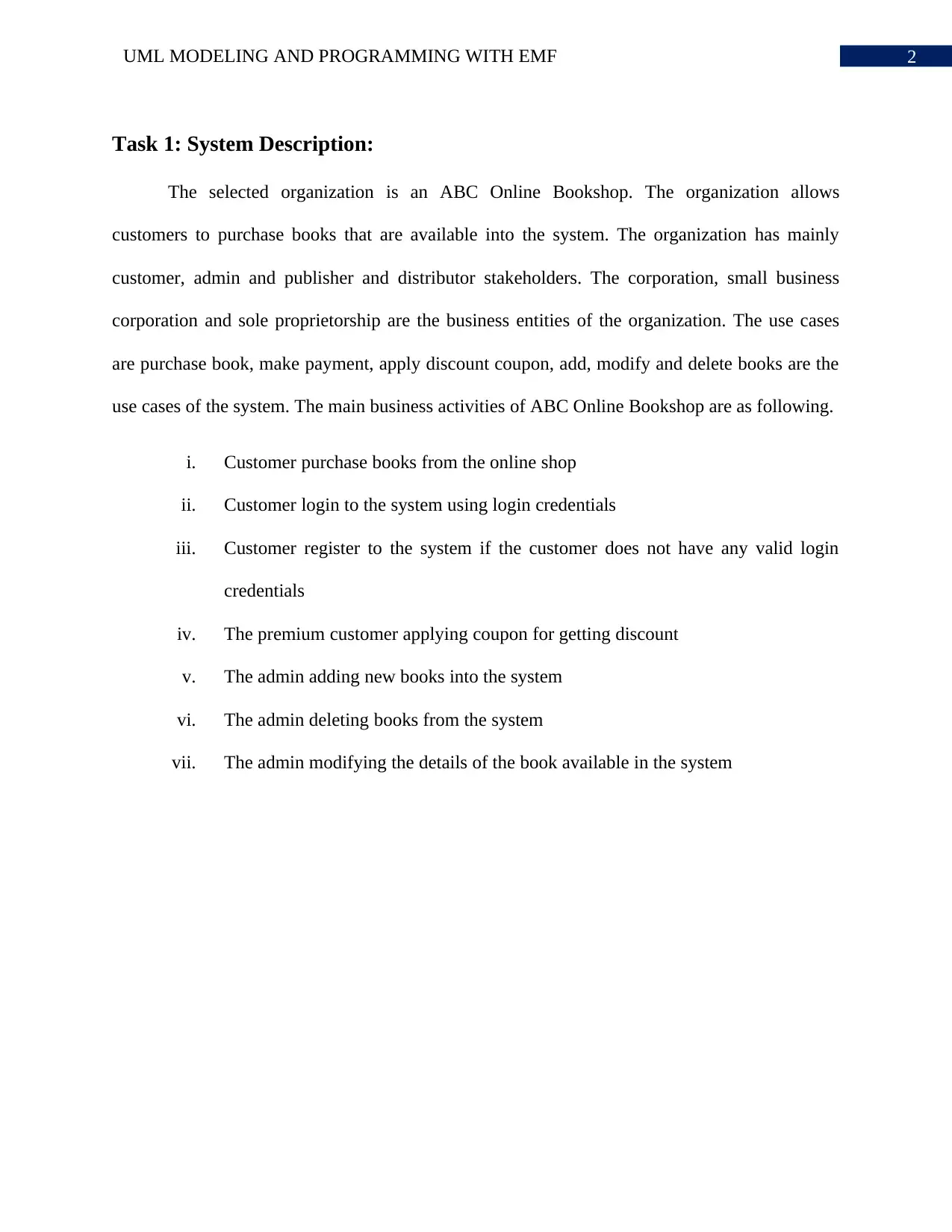
2UML MODELING AND PROGRAMMING WITH EMF
Task 1: System Description:
The selected organization is an ABC Online Bookshop. The organization allows
customers to purchase books that are available into the system. The organization has mainly
customer, admin and publisher and distributor stakeholders. The corporation, small business
corporation and sole proprietorship are the business entities of the organization. The use cases
are purchase book, make payment, apply discount coupon, add, modify and delete books are the
use cases of the system. The main business activities of ABC Online Bookshop are as following.
i. Customer purchase books from the online shop
ii. Customer login to the system using login credentials
iii. Customer register to the system if the customer does not have any valid login
credentials
iv. The premium customer applying coupon for getting discount
v. The admin adding new books into the system
vi. The admin deleting books from the system
vii. The admin modifying the details of the book available in the system
Task 1: System Description:
The selected organization is an ABC Online Bookshop. The organization allows
customers to purchase books that are available into the system. The organization has mainly
customer, admin and publisher and distributor stakeholders. The corporation, small business
corporation and sole proprietorship are the business entities of the organization. The use cases
are purchase book, make payment, apply discount coupon, add, modify and delete books are the
use cases of the system. The main business activities of ABC Online Bookshop are as following.
i. Customer purchase books from the online shop
ii. Customer login to the system using login credentials
iii. Customer register to the system if the customer does not have any valid login
credentials
iv. The premium customer applying coupon for getting discount
v. The admin adding new books into the system
vi. The admin deleting books from the system
vii. The admin modifying the details of the book available in the system
⊘ This is a preview!⊘
Do you want full access?
Subscribe today to unlock all pages.

Trusted by 1+ million students worldwide
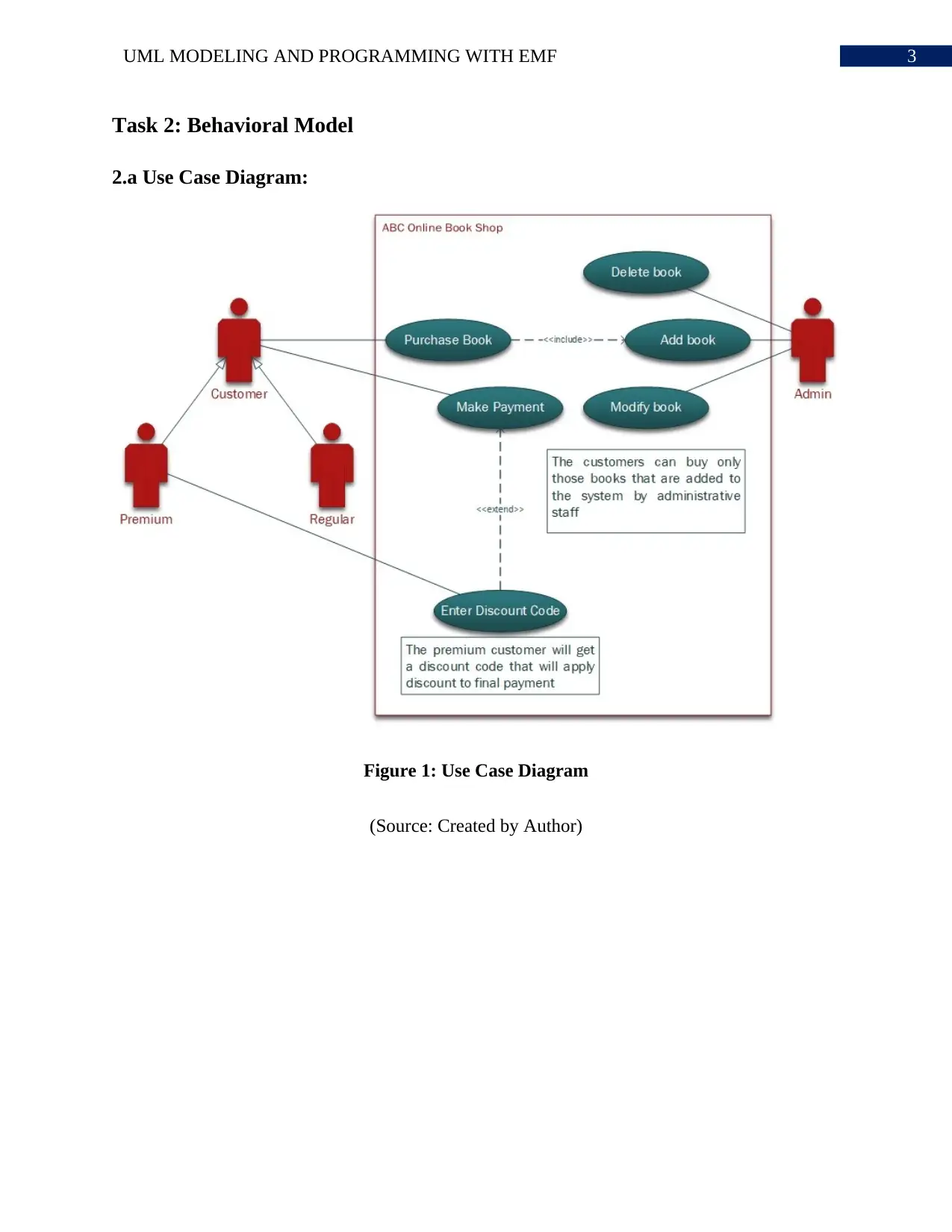
3UML MODELING AND PROGRAMMING WITH EMF
Task 2: Behavioral Model
2.a Use Case Diagram:
Figure 1: Use Case Diagram
(Source: Created by Author)
Task 2: Behavioral Model
2.a Use Case Diagram:
Figure 1: Use Case Diagram
(Source: Created by Author)
Paraphrase This Document
Need a fresh take? Get an instant paraphrase of this document with our AI Paraphraser
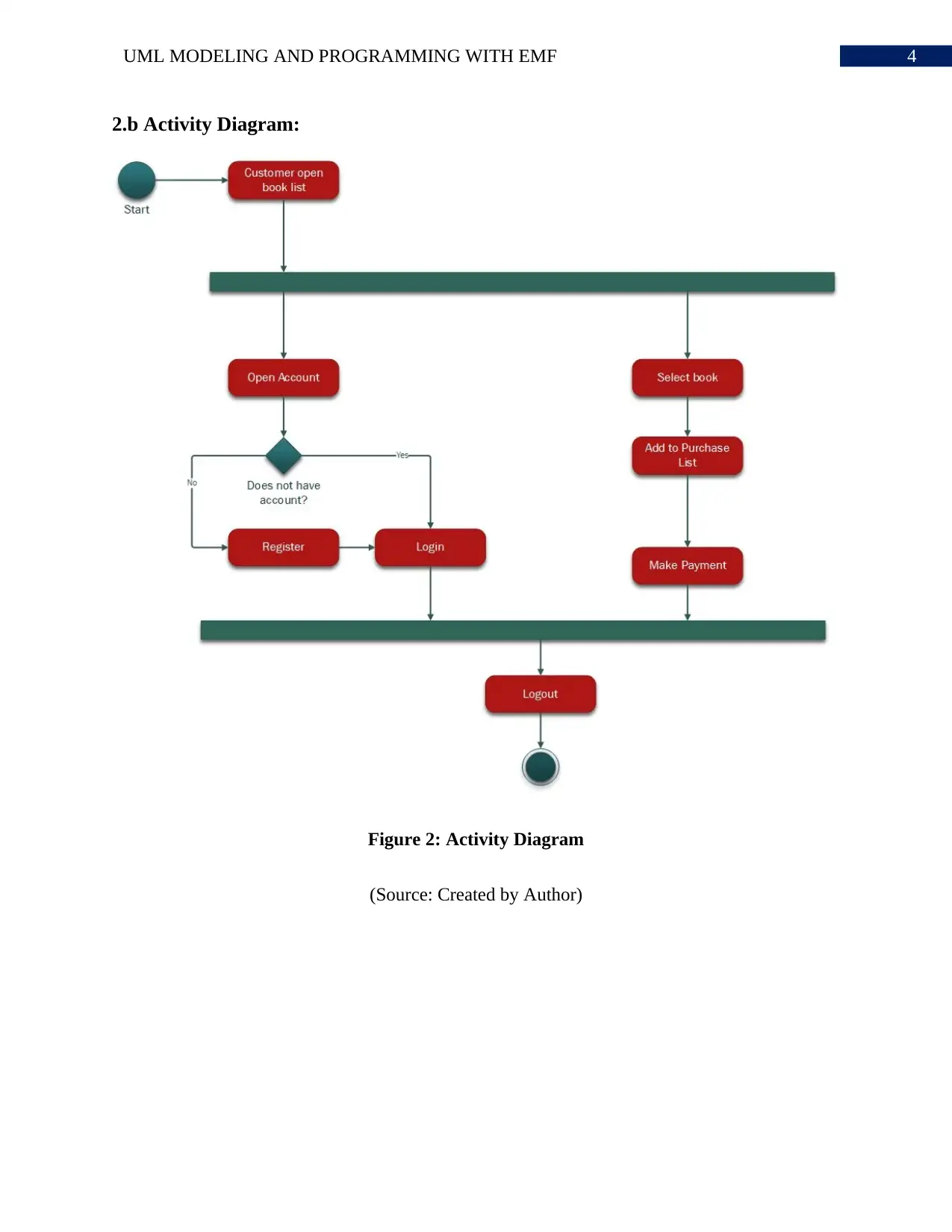
4UML MODELING AND PROGRAMMING WITH EMF
2.b Activity Diagram:
Figure 2: Activity Diagram
(Source: Created by Author)
2.b Activity Diagram:
Figure 2: Activity Diagram
(Source: Created by Author)
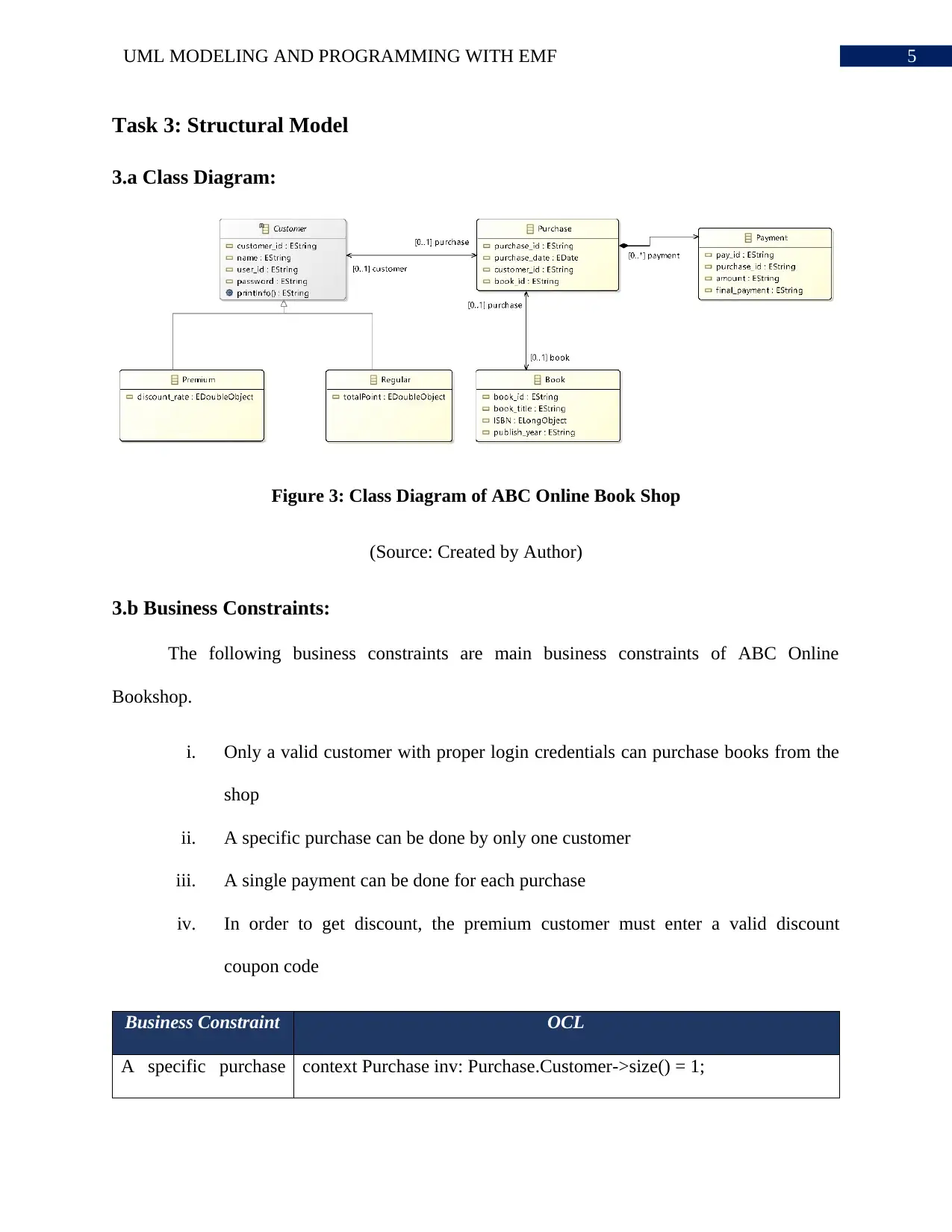
5UML MODELING AND PROGRAMMING WITH EMF
Task 3: Structural Model
3.a Class Diagram:
Figure 3: Class Diagram of ABC Online Book Shop
(Source: Created by Author)
3.b Business Constraints:
The following business constraints are main business constraints of ABC Online
Bookshop.
i. Only a valid customer with proper login credentials can purchase books from the
shop
ii. A specific purchase can be done by only one customer
iii. A single payment can be done for each purchase
iv. In order to get discount, the premium customer must enter a valid discount
coupon code
Business Constraint OCL
A specific purchase context Purchase inv: Purchase.Customer->size() = 1;
Task 3: Structural Model
3.a Class Diagram:
Figure 3: Class Diagram of ABC Online Book Shop
(Source: Created by Author)
3.b Business Constraints:
The following business constraints are main business constraints of ABC Online
Bookshop.
i. Only a valid customer with proper login credentials can purchase books from the
shop
ii. A specific purchase can be done by only one customer
iii. A single payment can be done for each purchase
iv. In order to get discount, the premium customer must enter a valid discount
coupon code
Business Constraint OCL
A specific purchase context Purchase inv: Purchase.Customer->size() = 1;
⊘ This is a preview!⊘
Do you want full access?
Subscribe today to unlock all pages.

Trusted by 1+ million students worldwide
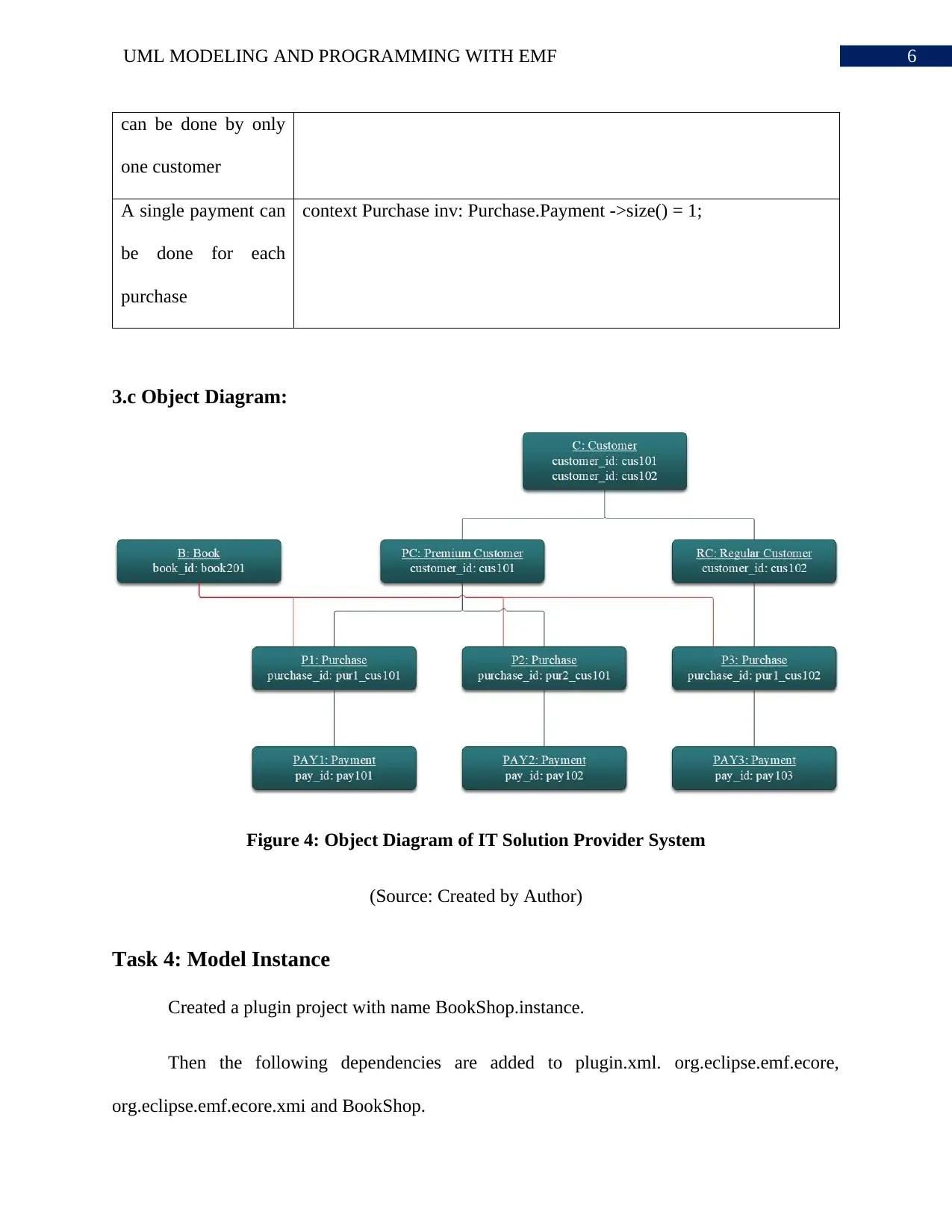
6UML MODELING AND PROGRAMMING WITH EMF
can be done by only
one customer
A single payment can
be done for each
purchase
context Purchase inv: Purchase.Payment ->size() = 1;
3.c Object Diagram:
Figure 4: Object Diagram of IT Solution Provider System
(Source: Created by Author)
Task 4: Model Instance
Created a plugin project with name BookShop.instance.
Then the following dependencies are added to plugin.xml. org.eclipse.emf.ecore,
org.eclipse.emf.ecore.xmi and BookShop.
can be done by only
one customer
A single payment can
be done for each
purchase
context Purchase inv: Purchase.Payment ->size() = 1;
3.c Object Diagram:
Figure 4: Object Diagram of IT Solution Provider System
(Source: Created by Author)
Task 4: Model Instance
Created a plugin project with name BookShop.instance.
Then the following dependencies are added to plugin.xml. org.eclipse.emf.ecore,
org.eclipse.emf.ecore.xmi and BookShop.
Paraphrase This Document
Need a fresh take? Get an instant paraphrase of this document with our AI Paraphraser
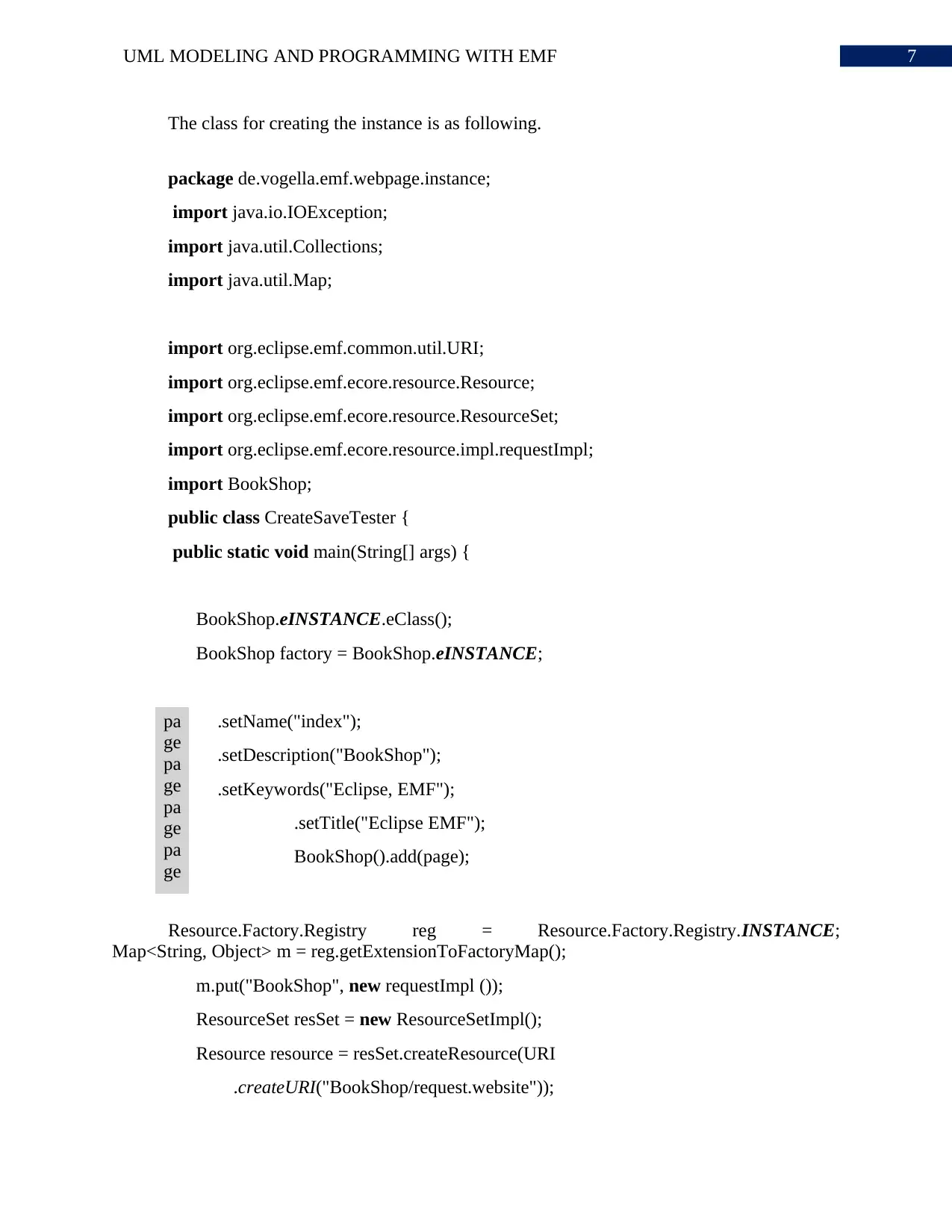
7UML MODELING AND PROGRAMMING WITH EMF
The class for creating the instance is as following.
package de.vogella.emf.webpage.instance;
import java.io.IOException;
import java.util.Collections;
import java.util.Map;
import org.eclipse.emf.common.util.URI;
import org.eclipse.emf.ecore.resource.Resource;
import org.eclipse.emf.ecore.resource.ResourceSet;
import org.eclipse.emf.ecore.resource.impl.requestImpl;
import BookShop;
public class CreateSaveTester {
public static void main(String[] args) {
BookShop.eINSTANCE.eClass();
BookShop factory = BookShop.eINSTANCE;
.setName("index");
.setDescription("BookShop");
.setKeywords("Eclipse, EMF");
.setTitle("Eclipse EMF");
BookShop().add(page);
Resource.Factory.Registry reg = Resource.Factory.Registry.INSTANCE;
Map<String, Object> m = reg.getExtensionToFactoryMap();
m.put("BookShop", new requestImpl ());
ResourceSet resSet = new ResourceSetImpl();
Resource resource = resSet.createResource(URI
.createURI("BookShop/request.website"));
pa
ge
pa
ge
pa
ge
pa
ge
The class for creating the instance is as following.
package de.vogella.emf.webpage.instance;
import java.io.IOException;
import java.util.Collections;
import java.util.Map;
import org.eclipse.emf.common.util.URI;
import org.eclipse.emf.ecore.resource.Resource;
import org.eclipse.emf.ecore.resource.ResourceSet;
import org.eclipse.emf.ecore.resource.impl.requestImpl;
import BookShop;
public class CreateSaveTester {
public static void main(String[] args) {
BookShop.eINSTANCE.eClass();
BookShop factory = BookShop.eINSTANCE;
.setName("index");
.setDescription("BookShop");
.setKeywords("Eclipse, EMF");
.setTitle("Eclipse EMF");
BookShop().add(page);
Resource.Factory.Registry reg = Resource.Factory.Registry.INSTANCE;
Map<String, Object> m = reg.getExtensionToFactoryMap();
m.put("BookShop", new requestImpl ());
ResourceSet resSet = new ResourceSetImpl();
Resource resource = resSet.createResource(URI
.createURI("BookShop/request.website"));
pa
ge
pa
ge
pa
ge
pa
ge
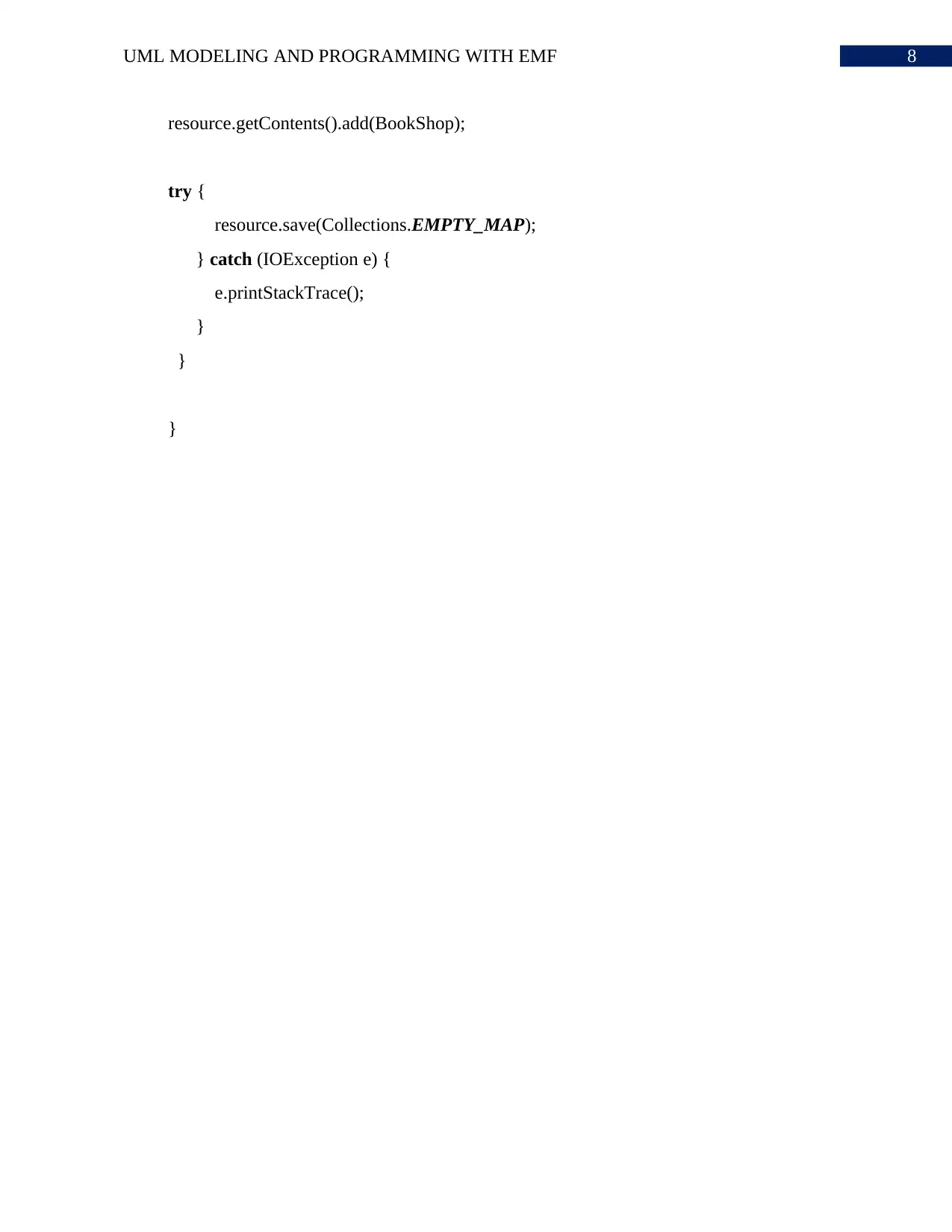
8UML MODELING AND PROGRAMMING WITH EMF
resource.getContents().add(BookShop);
try {
resource.save(Collections.EMPTY_MAP);
} catch (IOException e) {
e.printStackTrace();
}
}
}
resource.getContents().add(BookShop);
try {
resource.save(Collections.EMPTY_MAP);
} catch (IOException e) {
e.printStackTrace();
}
}
}
⊘ This is a preview!⊘
Do you want full access?
Subscribe today to unlock all pages.

Trusted by 1+ million students worldwide
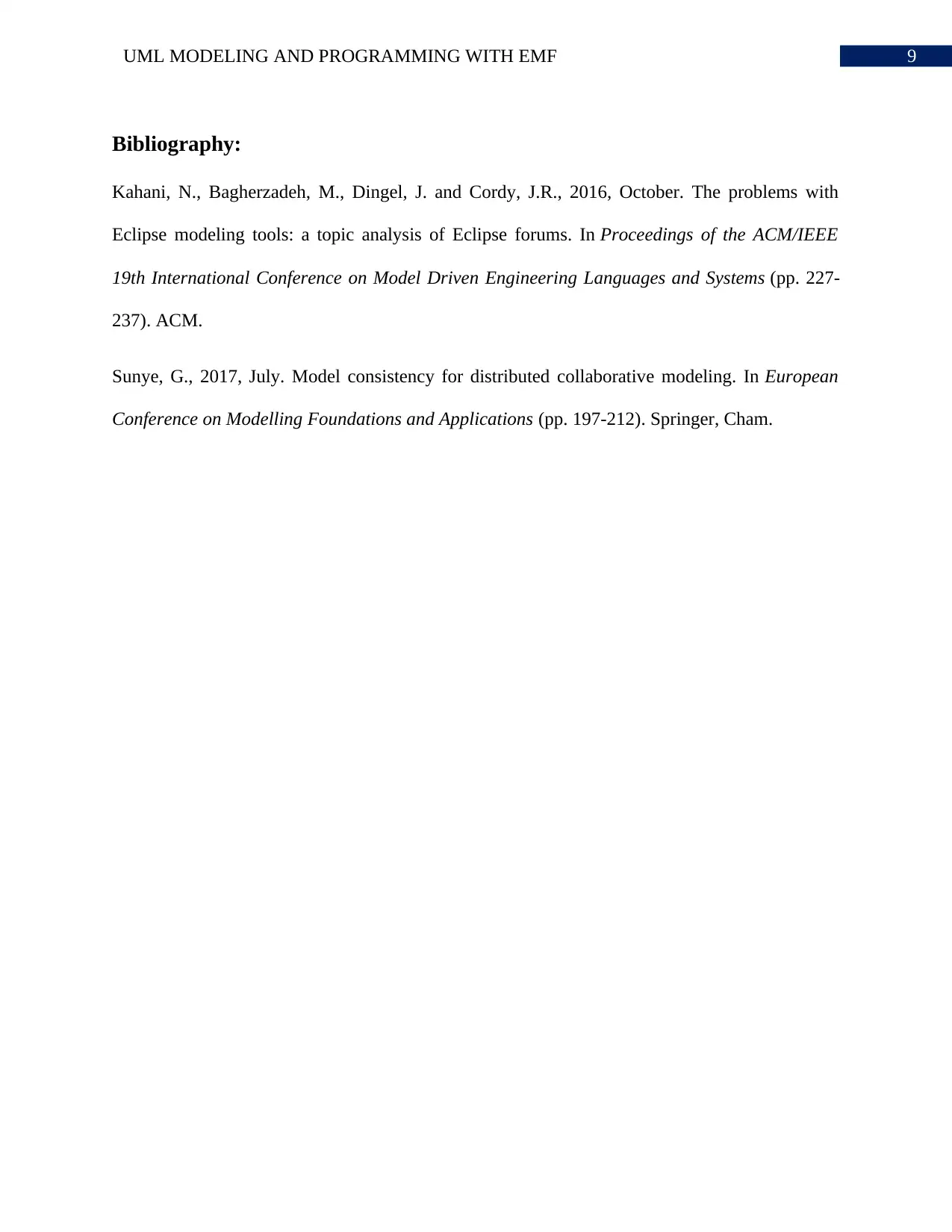
9UML MODELING AND PROGRAMMING WITH EMF
Bibliography:
Kahani, N., Bagherzadeh, M., Dingel, J. and Cordy, J.R., 2016, October. The problems with
Eclipse modeling tools: a topic analysis of Eclipse forums. In Proceedings of the ACM/IEEE
19th International Conference on Model Driven Engineering Languages and Systems (pp. 227-
237). ACM.
Sunye, G., 2017, July. Model consistency for distributed collaborative modeling. In European
Conference on Modelling Foundations and Applications (pp. 197-212). Springer, Cham.
Bibliography:
Kahani, N., Bagherzadeh, M., Dingel, J. and Cordy, J.R., 2016, October. The problems with
Eclipse modeling tools: a topic analysis of Eclipse forums. In Proceedings of the ACM/IEEE
19th International Conference on Model Driven Engineering Languages and Systems (pp. 227-
237). ACM.
Sunye, G., 2017, July. Model consistency for distributed collaborative modeling. In European
Conference on Modelling Foundations and Applications (pp. 197-212). Springer, Cham.
1 out of 10
Related Documents
Your All-in-One AI-Powered Toolkit for Academic Success.
+13062052269
info@desklib.com
Available 24*7 on WhatsApp / Email
![[object Object]](/_next/static/media/star-bottom.7253800d.svg)
Unlock your academic potential
Copyright © 2020–2025 A2Z Services. All Rights Reserved. Developed and managed by ZUCOL.




